With such a vast and diverse landscape that covers 65,000 square miles and has 1,350 miles of coastline, it’s not surprising that Florida is home to thousands of unique and wonderful animals. Amongst these are snakes, and Florida is home to more than 50 different species, including six that are venomous. Although some snakes are secretive and rarely seen, and some are endangered, there are some that we are more likely to come across than others. So join us as we explore some of the most common (and non-venomous) snakes in Florida!
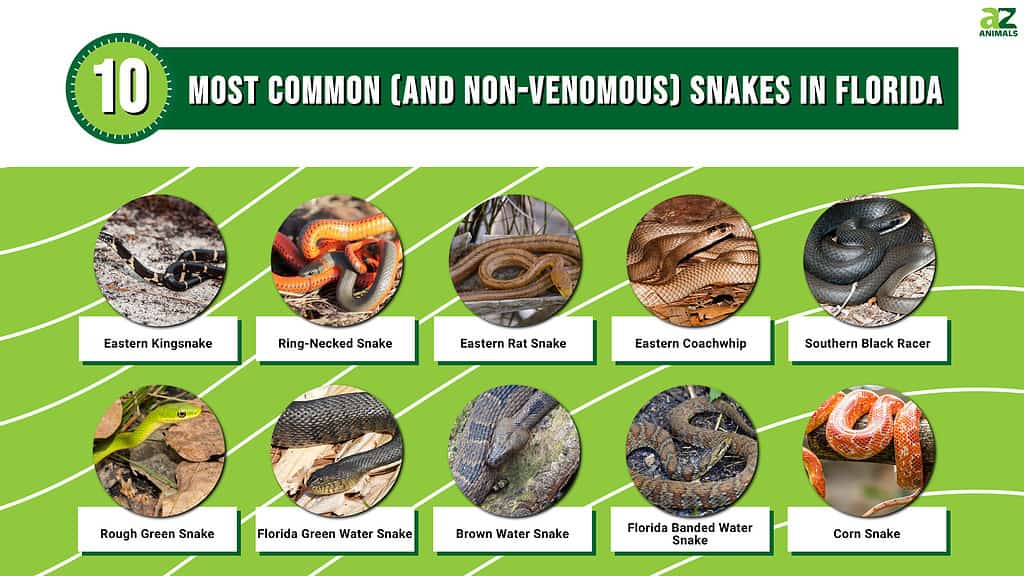
1. Eastern Kingsnake
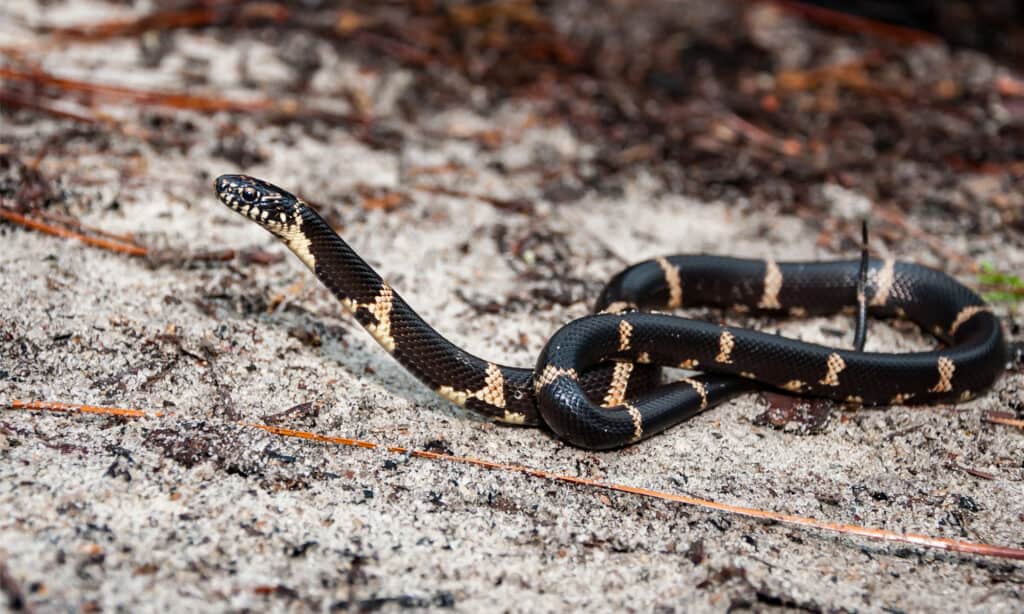
Eastern kingsnakes are found throughout most of Florida.
©iStock.com/JasonOndreicka
Also known as the common kingsnake, eastern kingsnakes are usually between 36 and 48 inches long. They have shiny scales and are dark brown with white crossbands down their back and a chain-like pattern down their sides. These snakes prefer open habitats such as grasslands, deserts, prairies, swamps, and alongside rivers and streams. However, they are also sometimes found in pine forests. They are found across much of Florida, with the exception of the eastern Apalachicola lowlands. These nonvenomous snakes are constrictors and eat a range of rodents, birds, lizards, frogs, and other snakes (including venomous copperheads and coral snakes).
2. Ring-Necked Snake
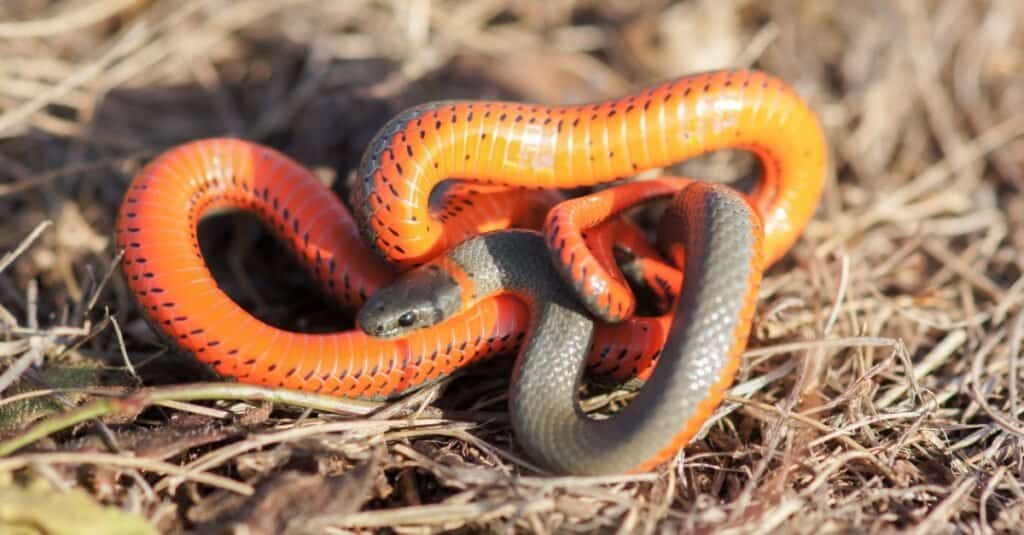
Small and colorful, the ring-necked snake is nocturnal and non-venomous.
©yhelfman/Shutterstock.com
Although secretive, the ring-necked snake is one of the most abundant and common snakes in Florida. There are twelve subspecies, of which two occur in Florida: Key ring-necked snakes and southern ring-necked snakes. Ring-necked snakes are only 8 to 14 inches long but are glossy black on their dorsal side and bright red, orange, or yellow on their bellies. They also have a bright ring of color around their neck which is what they are named for. Ring-necked snakes prefer areas with plenty of vegetation or cover for them to hide underneath, such as woodlands or rocky hillsides. Although they produce a mild venom-like substance, they are not truly venomous and pose no threat to humans or pets. This substance is produced in the Duvernoy gland and is used to immobilize prey such as salamanders.
3. Eastern Rat Snake
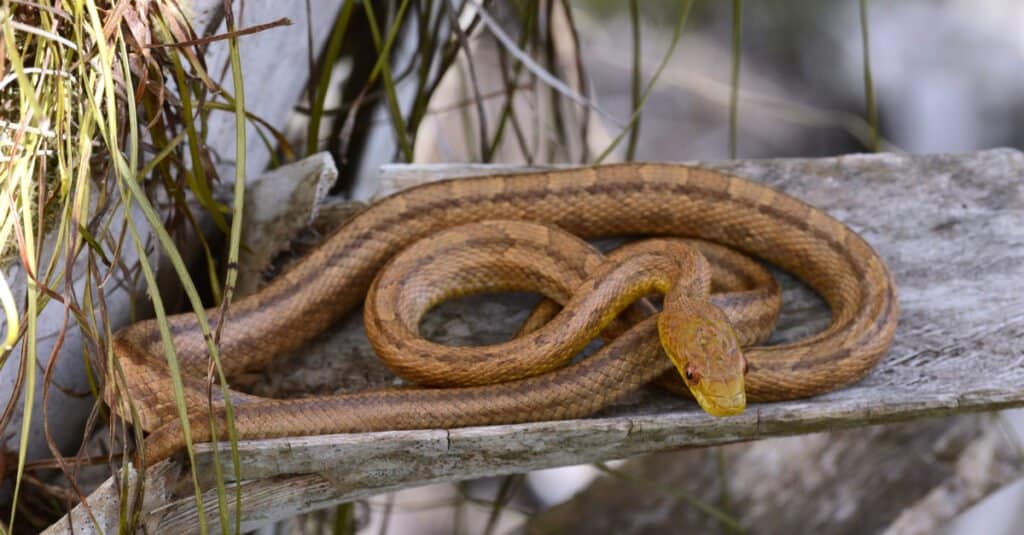
Eastern rat snakes live in forests and swamps and hibernate underground during winter.
©Patrick K. Campbell/Shutterstock.com
Also known as yellow rat snakes, eastern rat snakes in Florida are a yellowish-orange color with four darker stripes down their bodies. They are 36 to 72 inches long and are found east of the Apalachicola River and as far south as Key Largo. Eastern rat snakes prefer to live in hardwood forests and swamps, hibernating underground during the winter. They are harmless and usually flee when threatened. Their diet includes birds, rodents, frogs, and lizards.
4. Eastern Coachwhip
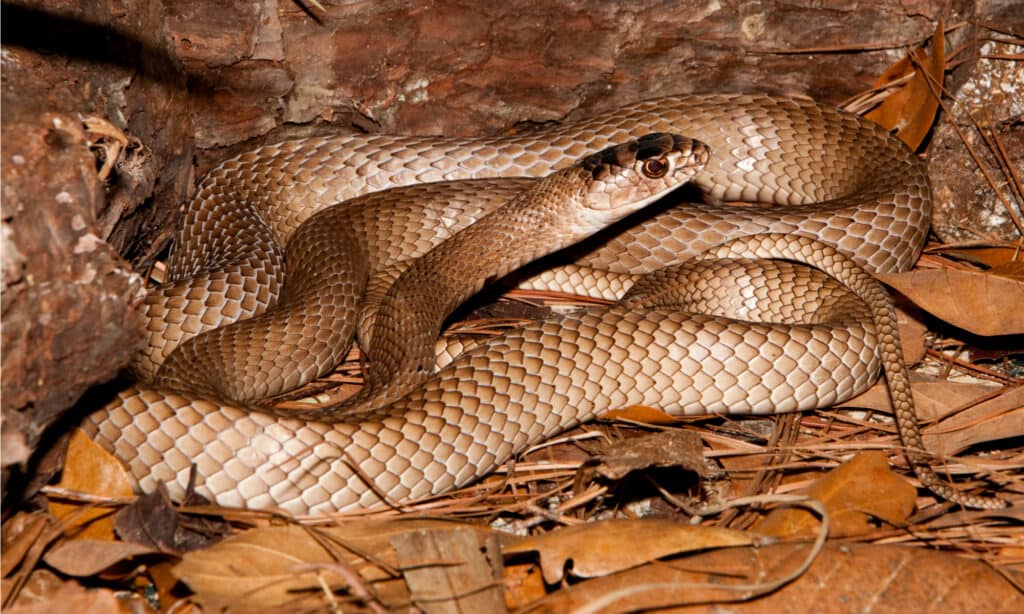
Eastern coachwhips are widespread throughout Florida, except for the Florida Keys.
©Jay Ondreicka/Shutterstock.com
Although there are six subspecies of coachwhip snakes, only the eastern coachwhip occurs in Florida. Eastern coachwhips are long, thin snakes that can reach up to 72 inches long. They have black heads and brown bodies, which gradually lighten towards their tail. Eastern coachwhips live in several habitats, although swamps, marshes, and pine woodlands are preferred. They are widespread throughout mainland Florida but are thought to be absent from the Florida Keys. Eastern coachwhips eat rodents, lizards, and small birds. They are diurnal (active during the day) and hunt by scanning the nearby area with their head raised above the ground. Despite being rumored to attack and whip people with their tails, eastern coachwhips are not aggressive and usually flee when disturbed.
5. Southern Black Racer
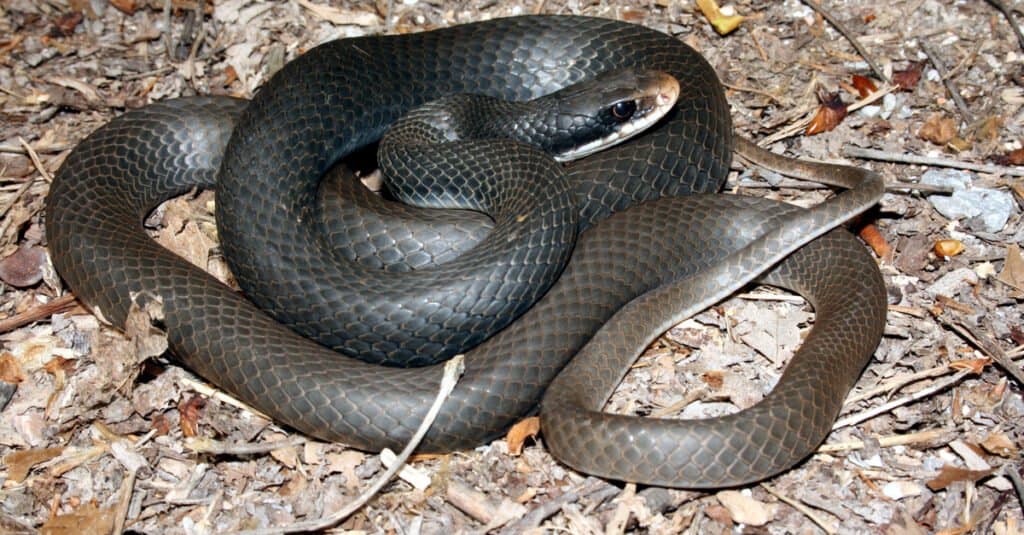
The diet of the southern black racer consists of birds, rodents, lizards, and frogs.
©Psychotic Nature/Shutterstock.com
One of eleven subspecies of eastern racers, southern black racers are easily one of the most widespread snakes in Florida and across the Florida Keys. Another subspecies — the Everglades racer — is found in the Florida Everglades. Southern black racers are 20 to 56 inches long and are bluish-black with white markings under their chin. They live in a wide range of habitats and are one of the most commonly seen snakes in Florida’s residential areas. Southern black racers are fast and agile and have keen eyesight. They eat a wide range of birds, rodents, lizards, and frogs.
6. Rough Green Snake
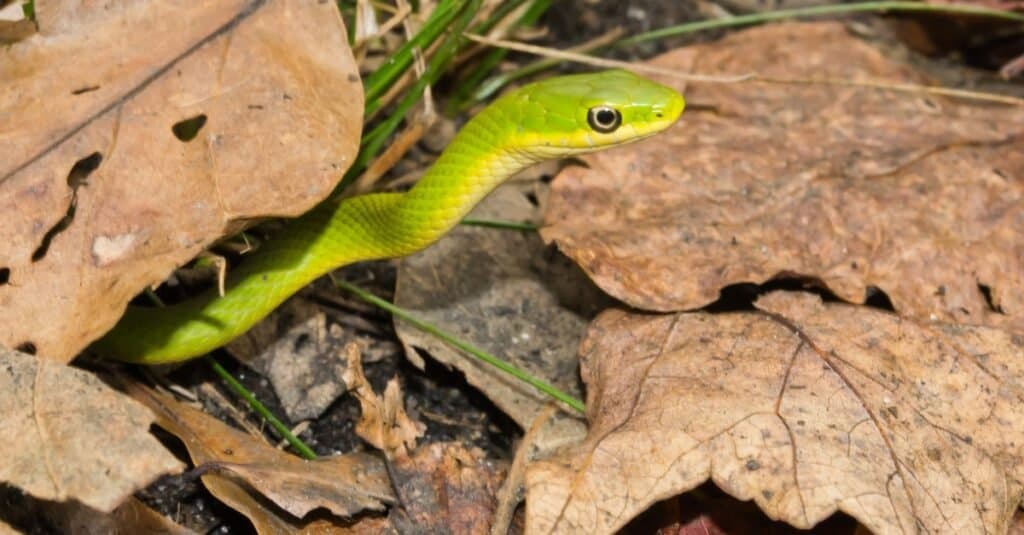
Because of their green and yellow coloring, rough green snakes can blend in easily with plant life.
©iStock.com/BobMcLeanLLC
One of the most brightly colored common snakes in Florida is the rough green snake. Rough green snakes are usually between 14 and 33 inches long and bright green on their dorsal side with yellow or cream bellies. They prefer to live in meadows and woodlands, although they are never very far from a permanent water source. Although rough green snakes are capable swimmers, they are also excellent climbers, typically spending much of their time in trees. Rough green snakes are widespread throughout Florida and the Florida Keys. They mainly eat insects and spiders, and their main predators are other snakes — particularly eastern racers and eastern kingsnakes.
7. Florida Green Water Snake
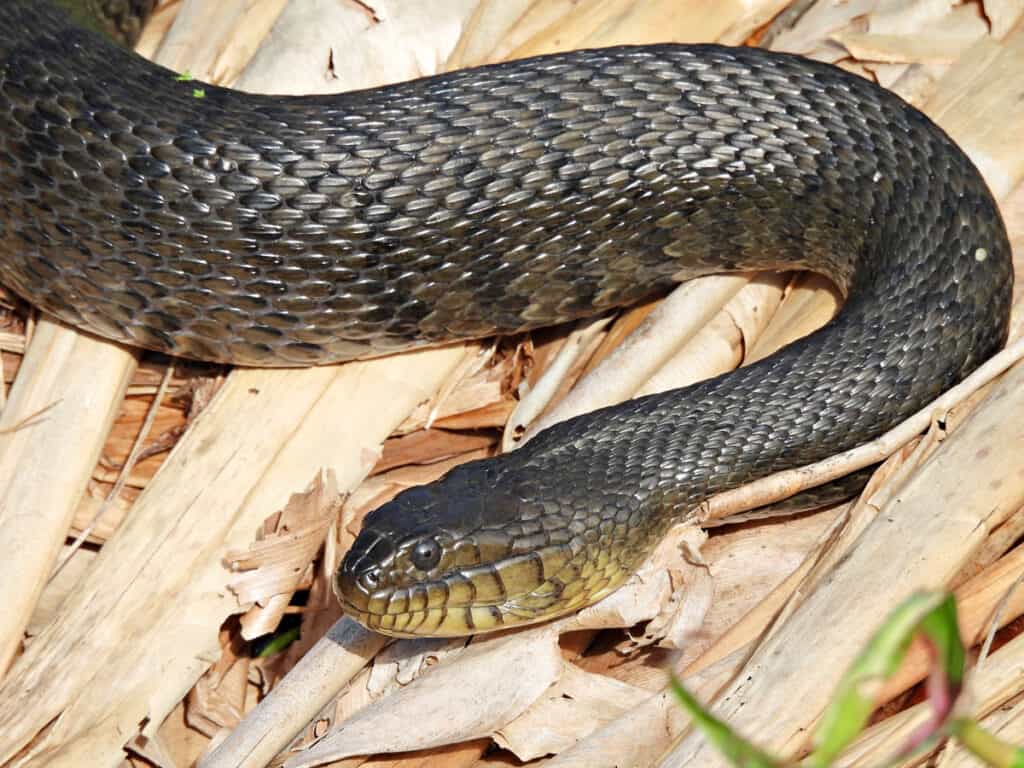
The Florida green water snake can be found all over Florida and has a distinctly large head.
©iStock.com/passion4nature
Originally classified as a subspecies of green water snakes, Florida green water snakes are now their own individual species. They are the longest water snakes in North America, reaching 30 to 55 inches long. Florida green water snakes are greenish-brown with dark speckles and lighter bellies. They live in slow-moving water such as ponds, lakes, and swamps, where there is plenty of vegetation for them to hide in. They are found across much of mainland Florida, although they are absent from the Florida Keys. Florida green water snakes are not venomous or aggressive towards people, nor are they constrictors. Instead, prey such as fish, frogs, and salamanders are grabbed and swallowed alive. Their main predators are kingsnakes, hawks, and alligators.
8. Brown Water Snake
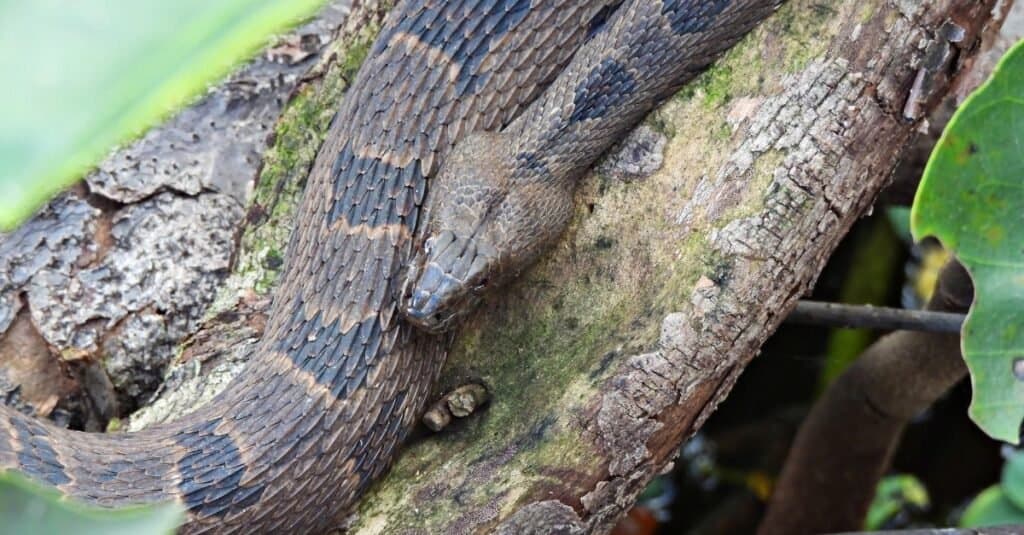
Brown water snakes have a triangular head, with the eyes being set toward the top.
©iStock.com/passion4nature
One of the most common species of water snakes in Florida is the brown water snake. Brown water snakes are 30 to 60 inches long and have heavy bodies with a neck that is distinctly narrower than their head. They live in flowing water such as rivers, streams, and canals and are found throughout most of Florida but not in the Florida Keys. Brown water snakes typically flee into the water when they are approached, but although they are not venomous, they will bite if they are cornered. They feed on fish, and young catfish make up most of their diet.
9. Florida Banded Water Snake
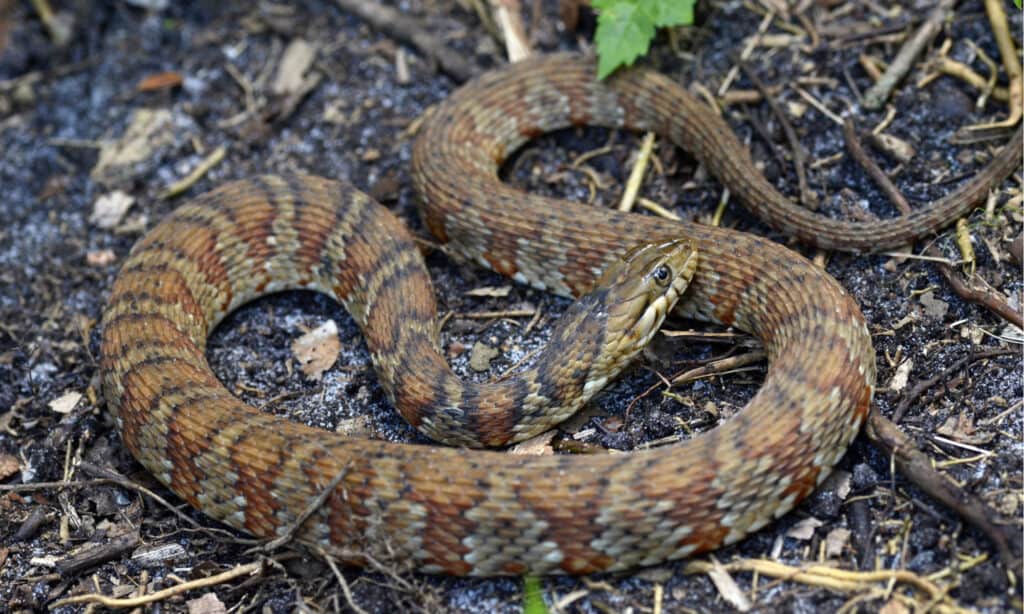
Florida banded water snakes are endemic to Florida and live in shallow freshwater.
©Patrick K. Campbell/Shutterstock.com
A subspecies of the banded water snake, Florida banded water snakes are endemic to Florida and southeastern Georgia. They are 24 to 42 inches long and are light brown or yellow with brown or black crossband markings. They live in shallow freshwater areas such as swamps, marshes, and ponds throughout mainland Florida. Florida banded water snakes are nocturnal, and their main diet consists of fish and frogs, which are both swallowed alive. Although they are nonvenomous and prefer to flee in the face of danger, they strike when threatened. They also vibrate the tip of their tail as a warning.
10. Corn Snake
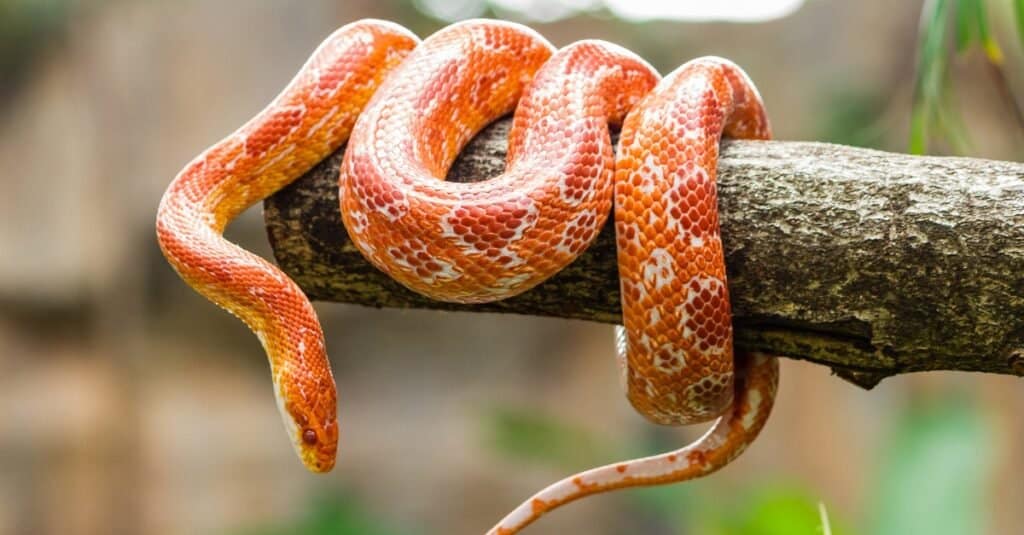
Corn snakes are one of the most widespread snakes and are popular pets.
©iStock.com/bugphai
Easily one of the most common and nonvenomous snakes in Florida is the corn snake which is found right across Florida and in the Florida Keys. These large snakes are 30 to 48 inches long and are incredibly popular as pets. Corn snakes are typically brown or orange with large red blotches on their bodies. They live in a range of habitats such as overgrown fields, forest openings, trees, and abandoned farms. Corn snakes earned their name due to their continued presence around grain stores, where they keep rodent populations in check. This actually makes them very beneficial, as the rodents would otherwise damage crops. Corn snakes are not aggressive, and if threatened, they usually vibrate the tip of their tail as a warning signal.
Summary of 10 of the Most Common (and Non-Venomous) Snakes in Florida
Here’s a recap of the snake species in the state of Florida that we took a close look at:
| Index | Species | Location |
|---|---|---|
| 1 | Eastern Kingsnake | Throughout Florida, with the exception of the eastern Apalachicola lowlands |
| 2 | Ring-Necked Snake | Throughout Florida |
| 3 | Eastern Rat Snake | East of the Apalachicola River and as far south as Key Largo |
| 4 | Eastern coachwhip | Throughout mainland Florida (except for the Florida Keys) |
| 5 | Southern Black Racer | Throughout Florida |
| 6 | Rough Green Snake | Throughout Florida and the Florida Keys |
| 7 | Florida Green Water Snake | Throughout most of mainland Florida (except for the Florida Keys) |
| 8 | Brown Water Snake | Throughout most of Florida (except for the Florida Keys) |
| 9 | Florida Banded Water Snake | Throughout mainland Florida |
| 10 | Corn Snake | Throughout Florida and the Florida Keys |
Other Common Reptiles in Florida
Green Anoles
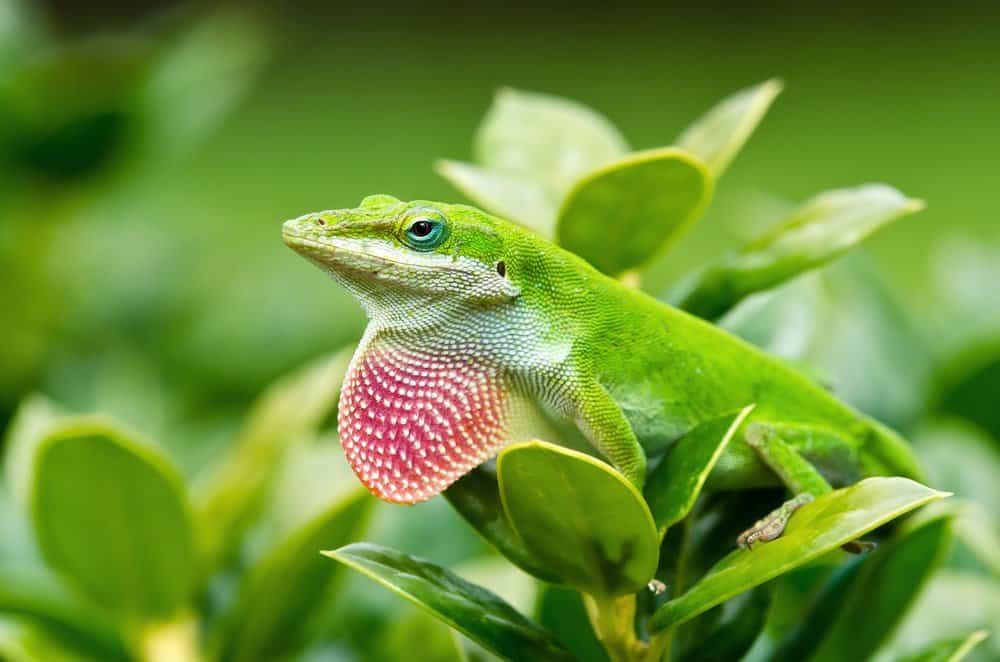
Green anole lizards are generally 5 -8 inches long.
©Leena Robinson/Shutterstock.com
Native to the Bahamas, the Cayman Islands, and Cuba, green anoles (Anolis carolinensis) are known for their pointy snouts, bright green coloration, and the presence of a dewflap in males. They can be found in urban environments where they keep insect populations in check due to a mainly insectivorous diet. Although they are not true chameleons, green anoles are capable of switching their color to a dull brown.
Brown Anoles
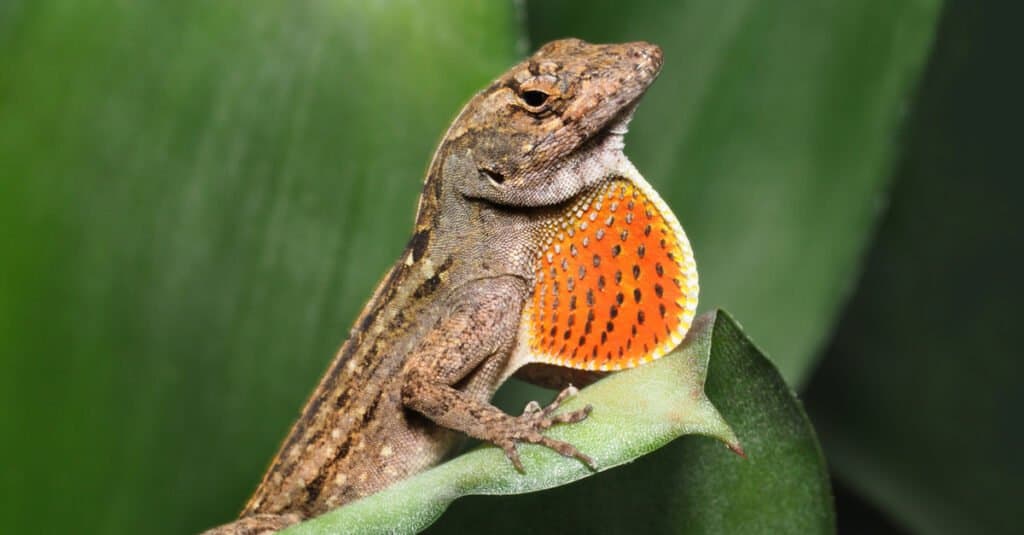
Male Brown Anole lizards are the same size as green anoles but lack their color-swapping abilities.
©Steve Bower/Shutterstock.com
Native to Cuba, this lizard arrived about a century ago in Florida and its presence has since been bolstered by subsequent arrivals. The same size as the green anole (5-8 inches), the brown anole has a shorter snout, speckled brown coloring, and a dewlap with a white fringe. It also has a rather worrisome habit of snacking on young green anoles and is responsible for their declining numbers in the state. Brown anoles lack the color-swapping superpowers of their green-skinned relatives.
Bonus: Which U.S. State Has the Most Snake Bites?
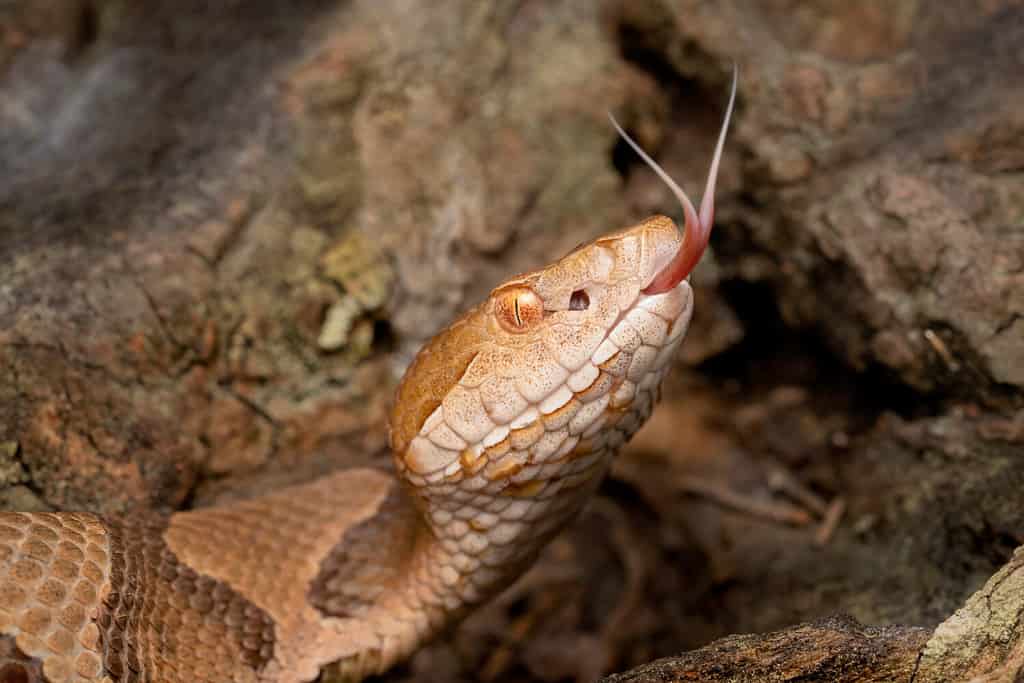
The venomous copperhead snake is among those responsible for snake bites in North Carolina.
©Mark_Kostich/Shutterstock.com
Now that you’re familiar with some of the snakes found in Florida, you may be wondering what the chances are of you getting bitten by one. The Florida Department of State published “The Florida Handbook,” which states that there are an average of 300 venomous snakebites that occur in the state each year, though fatalities from them are rare. That may sound like a lot, but there are other states that rank much higher in annual snake bites.
So which state ranks the highest in snake bites? That would be North Carolina. The snake bite rate in this southeastern state is 157.8 bites per million population annually. As the population as of 2021 was a little over 10 million (10.55 to be exact), and we were to just figure it off of 10 million, that would average out to roughly 1,580 reported snake bites per year.
The top 6 states for reported snake bites are:
- North Carolina 157.8 bites per million
- West Virginia 105.3 bites per million
- Arkansas 92.9 bites per million
- Oklahoma 61 bites per million
- Virginia 48.7 bites per million
- Texas 44.2 bites per million
There are 6 different kinds of venomous snakes inhabiting North Carolina: copperhead, cottonmouth, eastern coral snake, eastern diamondback rattlesnake, pigmy rattlesnake, and timber rattlesnake. In the year 2019, there were 92 people bitten by venomous snakes in that state.
The photo featured at the top of this post is © iStock.com/bugphai
Discover the "Monster" Snake 5X Bigger than an Anaconda
Every day A-Z Animals sends out some of the most incredible facts in the world from our free newsletter. Want to discover the 10 most beautiful snakes in the world, a "snake island" where you're never more than 3 feet from danger, or a "monster" snake 5X larger than an anaconda? Then sign up right now and you'll start receiving our daily newsletter absolutely free.
Thank you for reading! Have some feedback for us? Contact the AZ Animals editorial team.






